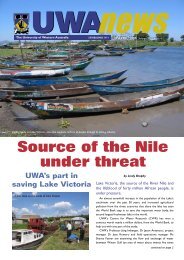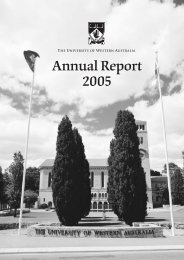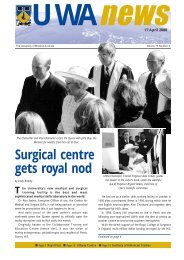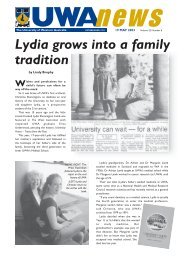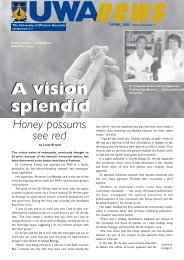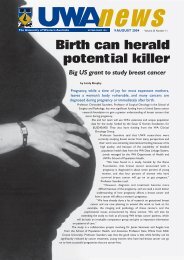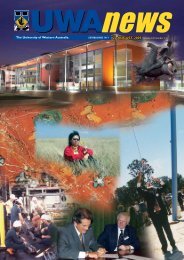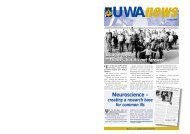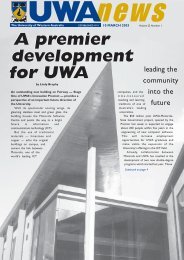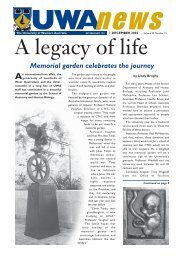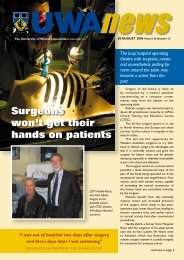July 24, 2000 - Publications Unit - The University of Western Australia
July 24, 2000 - Publications Unit - The University of Western Australia
July 24, 2000 - Publications Unit - The University of Western Australia
You also want an ePaper? Increase the reach of your titles
YUMPU automatically turns print PDFs into web optimized ePapers that Google loves.
2 UWA newsVCariousthoughts …vc@acs.uwa.edu.auNotes from the NorthThis time I determined to take the GreatNorthern Highway to the northwest. I hadalways previously taken the coastal highway viaGeraldton and the beauties <strong>of</strong> Shark Bay on theExmouth Peninsula and Coral Bay, or I had takenthe convenience <strong>of</strong> an airflight to the Pilbara.But now I had the opportunity <strong>of</strong> a week’s recreation leaveand a chance to explore that inland road and the variety <strong>of</strong>mining towns in the extraordinary landscape which the‘Great Northern’ cuts across, especially from Mount Magnetto Port Hedland.I write these notes from the Kimberley, after thatmemorable journey through the Hamersley and OpthalmiaRanges, with their amazing rocky outcrops, gorges and treeedgedhorizons. Almost like driving within one <strong>of</strong> the FredWilliams’ paintings, in his brilliantly evocative Pilbara series!Exceptional environments aside, such a journey alsoreinforces some very contemporary ideas for WA, and forour <strong>University</strong>, in this new century.Most <strong>of</strong> all what really hits home to the attentive observer isthe way in which the modern mining and energy industries— be they in Mt Magnet, or Newman, or the BurrupPeninsular — combine the extraction systems with processengineering, itself heavily dependent on the latest discoveriesand innovations in science.Compared to the world <strong>of</strong> mining sites when my father wasa mine engineer, these new industrial plants today are asmuch about the chemical sciences and high technology asthey are about the ore body itself, its extraction andcrushing; some are also manufacturing plants. This valueadding,through science and technology, is what producesthe real wealth and prosperity <strong>of</strong> WA.How good, I thought, that generic ‘science’ (and ‘high-tech’engineering) is so prominent within the UWA mission, andalso so well connected to the character <strong>of</strong> the state, in ournew draft Academic Pr<strong>of</strong>ile which identifies the key directionalareas <strong>of</strong> our research. How good too that UWA is planningto invest significantly in a major capital works projectdevoted to the chemical sciences.On a national scale I was also very pleased to read the majornew ARC Report, “Inventing Our Future: the Link Between<strong>Australia</strong>n Patenting and Basic Science”. Inspired by the nowfamous Francis Narin study in the USA, and indeed involvingNarin himself, the report shows that some 97 per cent <strong>of</strong> all<strong>Australia</strong>n research cited in <strong>Australia</strong>n invented US patents isauthored by public sector institutions. Of this figure, abouttwo thirds <strong>of</strong> the research originates at <strong>Australia</strong>nuniversities and affiliated medical research centres. Mostimportantly, the study demonstrates the strong reliance onuniversity papers in the development <strong>of</strong> private sectorpatents. <strong>The</strong>se papers are the most heavily cited resource <strong>of</strong>private companies.“Inventing our Future . . .” (to be found on the ARC website at http://www.arc.gov.au) indeed substantiates in arigorous, scholarly way what the interested traveller in thevast reaches <strong>of</strong> our state can observe. <strong>University</strong> science andengineering ultimately matters greatly. Beyond the miningindustry, it can be found in the vital knowledge agenda, inagricultural production, marine exploration and the newindustries, ranging from viticulture and winemaking to ITcompanies and the new medical applications <strong>of</strong> majorlaboratory research.We have recently hosted the national conference <strong>of</strong> the<strong>Australia</strong>n Science Teachers’ Association and it wasimportant to share these ideas with them in supporting theirimportant work in attracting more students into genericscience at school and generally propagating the excitement,let alone the importance <strong>of</strong> science, in a world increasinglyreliant on new knowledge.Of course, that world <strong>of</strong> ‘knowledge’ will also involve socialand human sciences. <strong>The</strong> new technocratic orderincorporates organisational knowledge and financialexpertise, from the social sciences, while our all too humanresponses to change and new scientific knowledge call uponthe humanities. All that can be seen in the north <strong>of</strong> our stateas well, a new society in an ancient landscape.More personally, this journey to the Pilbara and Kimberleyhas challenged my thoughts about ‘land, place, culture andidentity’, the powerful theme <strong>of</strong> an Institute <strong>of</strong> AdvancedStudies program this year.Yes, I decided, my sense <strong>of</strong> being an <strong>Australia</strong>n is deeplyaffected by the landscape. I can learn from Aboriginal ways<strong>of</strong> ‘seeing’ that environment. I can have it theorised by ourhumanities’ scholars. And I can take the Great NorthernHighway.Pr<strong>of</strong>essor Deryck M. SchreuderVice-Chancellor and PresidentTHE UNIVERSITY OF WESTERN AUSTRALIA • JULY <strong>24</strong> <strong>2000</strong>



